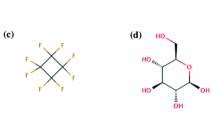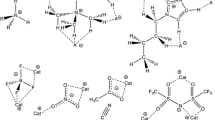Abstract
A linear correlation between harmonic and anharmonic frequencies of water calculated at B3LYP level of theory was observed with a number of basis sets. Similar relationships were found in both the gas phase and solution for several small molecules. The best correlation was found for C = O stretch mode in formaldehyde, formamide and N-methylacetamide. The average difference between B3LYP harmonic and anharmonic ν(C = O) frequencies calculated with several basis sets in these molecules was 30 cm−1. The ad hoc correction of −30 cm−1, added to harmonic frequencies of two different carbonyl groups present in a structure of a larger molecule was tested as a fast way of predicting anharmonic frequencies without elaborated calculations. The proposed approach was tested successfully on a larger molecule of E and Z isomers of N-acetyl-α,β-dehydrophenylalanine N′,N′-dimethylamide [Ac-(E/Z)-ΔPhe-NMe2] and the estimated anharmonic ν(C = O) frequencies were close to directly calculated results.

Correlation between calculated harmonic and anharmonic ν(C = O) frequencies of formamide in the gas phase and several solvents calculated with the B3LYP hybrid exchange-correlation functional using 21 basis sets in vacuum and 11 in solution








Similar content being viewed by others
References
Barth A (2007) Infrared spectroscopy of proteins. Biochim Biophys Acta 1767:1073–1101
Vass E, Hollosi M, Besson F, Buchet R (2003) Vibrational spectroscopic detection of beta- and gamma- turns in synthetic and natural peptides and proteins. Chem Rev 103:1917–1954
Hehre WJ, Radom L, PvR S, Pople JA (1986) Molecular orbital theory. Wiley, New York
Scott AP, Radom L (1996) Harmonic vibrational frequencies: an evaluation of Hartree-Fock, Møller-Plesset, quadratic configuration interaction, density functional theory, and semiempirical scale factors. J Phys Chem 100:16502–16513
Merrick JP, Moran D, Radom L (2007) An evaluation of harmonic vibrational frequency scale factors. J Phys Chem A 111:11683–11700
Sinha P, Boesch SE, Gu C, Wheeler RA, Wilson AK (2004) Harmonic vibrational frequencies: scaling factors for HF, B3LYP, and MP2 methods in combination with correlation consistent basis sets. J Phys Chem A 108:9213–9217
Boese AD, Klopper W, Martin JML (2005) Assessment of various density functionals and basis sets for the calculation of molecular anharmonic force fields. Int J Quant Chem 104:830–845
Boese AD, Klopper W, Martin JML (2005) Anharmonic force fields and thermodynamic functions using density functional theory. Mol Phys 103:863–876
Barone V (2004) Vibrational zero-point energies and thermodynamic functions beyond the harmonic approximation. J Chem Phys 120:3059–3065
Carbonniere P, Barone V (2004) Performances of different density functionals in the computation of vibrational spectra beyond the harmonic approximation. Chem Phys Lett 399:226–229
Carbonniere P, Bégué D, Pouchan C (2004) DFT quartic force field of acetonitrile by using a generalized least-squares procedure. Chem Phys Lett 393:92–97
Carbonniere P, Barone V (2004) Coriolis couplings in variational computations of vibrational spectra beyond the harmonic approximation: Implementation and validation. Chem Phys Lett 392:365–371
Carbonniere P, Begue D, Dargelos A, Pouchan C (2004) Construction of an accurate quartic force field by using generalised least-squares fitting and experimental design. Chem Phys 300:41–51
Barone V (2005) Anharmonic vibrational properties by a fully automated second-order perturbative approach. J Chem Phys 122:014108
Carbonniere P, Lucca T, Pouchan C, Rega N, Barone V (2005) Vibrational computations beyond the harmonic approximation: Performances of the B3LYP density functional for semirigid molecules. J Comput Chem 26:384–388
Bour P, Bednarova L (1995) Anharmonic force field of formamide. A computational study. J Phys Chem 99:5961–5966
Bounouar M, Scheurer C (2008) The impact of approximate VSCF schemes and curvilinear coordinates on the anharmonic vibrational frequencies of formamide and thioformamide. Chem Phys 347:194–207
Frisch MJ, Trucks GW, Schlegel HB, Scuseria GE, Robb MA, Cheeseman JR, Montgomery JA Jr, Vreven T, Kudin KN, Burant JC, Millam JM, Iyengar SS, Tomasi J, Barone V, Mennucci B, Cossi M, Scalmani G, Rega N, Petersson GA, Nakatsuji H, Hada M, Ehara M, Toyota K, Fukuda R, Hasegawa J, Ishida M, Nakajima T, Honda Y, Kitao O, Nakai H, Klene M, Li X, Knox JE, Hratchian HP, Cross JB, Bakken V, Adamo C, Jaramillo J, Gomperts R, Stratmann RE, Yazyev O, Austin AJ, Cammi R, Pomelli C, Ochterski JW, Ayala PY, Morokuma K, Voth GA, Salvador P, Dannenberg JJ, Zakrzewski VG, Dapprich S, Daniels AD, Strain MC, Farkas O, Malick DK, Rabuck AD, Raghavachari K, Foresman JB, Ortiz JV, Cui Q, Baboul AG, Clifford S, Cioslowski J, Stefanov BB, Liu G, Liashenko A, Piskorz P, Komaromi I, Martin RL, Fox DJ, Keith T, Al-Laham MA, Peng CY, Nanayakkara A, Challacombe M, Gill PMW, Johnson B, Chen W, Wong MW, Gonzalez C, Pople JA (2004) Gaussian 03, Revision E01. Gaussian, Wallingford
Frisch MJ, Trucks GW, Schlegel HB, Scuseria GE, Robb MA, Cheeseman JR, Montgomery JA Jr, Vreven T, Kudin KN, Burant JC, Millam JM, Iyengar SS, Tomasi J, Barone V, Mennucci B, Cossi M, Scalmani G, Rega N, Petersson GA, Nakatsuji H, Hada M, Ehara M, Toyota K, Fukuda R, Hasegawa J, Ishida M, Nakajima T, Honda Y, Kitao O, Nakai H, Klene M, Li X, Knox JE, Hratchian HP, Cross JB, Bakken V, Adamo C, Jaramillo J, Gomperts R, Stratmann RE, Yazyev O, Austin AJ, Cammi R, Pomelli C, Ochterski JW, Ayala PY, Morokuma K, Voth GA, Salvador P, Dannenberg JJ, Zakrzewski VG, Dapprich S, Daniels AD, Strain MC, Farkas O, Malick DK, Rabuck AD, Raghavachari K, Foresman JB, Ortiz JV, Cui Q, Baboul AG, Clifford S, Cioslowski J, Stefanov BB, Liu G, Liashenko A, Piskorz P, Komaromi I, Martin RL, Fox DJ (2009) Gaussian 09, Revision A.02. Gaussian, Wallingford, CT
Bowman JM (1978) Self-consistent field energies and wavefunctions for coupled oscillators. J Chem Phys 68:608–610
Bowman JM (1986) The self-consistent-field approach to polyatomic vibrations. Acc Chem Res 19:202–208
Gerber RB, Ratner MA (1988) Self-consistent field methods for vibrational excitation in polyatomic systems. Adv Chem Phys 70:97–132
Bounouar M, Scheurer C (2006) Reducing the vibrational coupling network in N-methylacetamide as a model for ab initio infrared spectra computations of peptides. Chem Phys 323:87–101
Norris LS, Ratner MA, Roitberg AE, Gerber RB (1996) Moller-Plesset perturbation theory applied to vibrational problems. J Chem Phys 105:11261–11267
Christiansen O (2007) Vibrational structure theory: New vibrational wave function methods for calculation of anharmonic vibrational energies and vibrational contributions to molecular properties. Phys Chem Chem Phys 9:2942–2953
Bowman JM, Christoffel K, Tobin F (1979) Application of SCF-CI theory to vibrational motion in polyatomic molecules. J Phys Chem 83:905–920
Christoffel KM, Bowman JM (1982) Investigations of self-consistent field, SCF CI and virtual state configuration interaction vibrational energies for a model three-mode system. Chem Phys Lett 85:220–224
Carter S, Bowman JM, Handy NC (1998) Extensions and tests of "multimode": a code to obtain accurate vibration/rotation energies of many-mode molecules. Theor Chem Acc 100:191–198
Christiansen O (2004) Vibrational coupled cluster theory. J Chem Phys 120:2149–2159
Buczek A, Kupka T, Broda MA (2011) Extrapolation of water and formaldehyde harmonic and anharmonic frequencies to the B3LYP/CBS limit using polarization consistent basis sets. J Mol Model 17:2029–2040
Buczek A, Kupka T, Broda MA (2011) Estimation of formamide harmonic and anharmonic modes in the Kohn-Sham limit using the polarization consistent basis sets. J Mol Model 17:2265–2274
Tomasi J, Mennucci B, Cammi R (2005) Quantum mechanical continuum solvation models. Chem Rev 105:2999–3093
Buczek A, Siodłak D, Bujak M, Broda MA (2011) The effects of side-chain orientation on the backbone conformation of dehydrophenylalanine residue. Theoretical and X-ray study. J Phys Chem B 115:4295–4306
Buczek AM, Ptak T, Kupka T, Broda MA (2011) Experimental and theoretical NMR and IR studies of the side-chain orientation effects on the backbone conformation of dehydrophenylalanine residue. Magn Reson Chem 49:343–349
Lee C, Yang W, Parr RG (1988) Development of the Colle-Salvetti correlation-energy formula into a functional of the electron density. Phys Rev B 37:785–789
Vosko SH, Wilk L, Nusair M (1980) Accurate spin-dependent electron liquid correlation energies for local spin density calculations: a critical analysis. Can J Phys 58:1200–1211
Becke AD (1993) Density-functional thermochemistry. III. The role of exact exchange. J Chem Phys 98:5648–5652
Stephens PJ, Devlin FJ, Chabalowski CF, Frisch MJ (1994) Ab initio calculations of vibrational absorbtion and circular dichroism spectra using density functional force fields. J Chem Phys 98:11623–11627
Dunning TH Jr (1989) Gaussian basis sets for use in correlated molecular calculations, I. The atoms boron through neon and hydrogen. J Chem Phys 90:1007–1023
Dunning TH Jr (2000) A road map for the calculation of molecular binding energies. J Phys Chem A 104:9062–9080
Wilson A, van Mourik T, Dunning TH Jr (1996) Gaussian basis sets for use in correlated molecular calculations. VI. Sextuple zeta correlation consistent basis sets for boron through neon. J Mol Struct (THEOCHEM) 388:339–349
Kendall RA, Dunning TH Jr, Harrison RJ (1992) Electron affinities of the first-row atoms revisited. Systematic basis sets and wave functions. J Chem Phys 96:6796–6806
Jensen F (1999) The basis set convergence of the Hartree-Fock energy for H2. J Chem Phys 110:6601–6605
Jensen F (2001) Polarization consistent basis sets: Principles. J Chem Phys 115:9113–9125
Jensen F (2002) Polarization consistent basis sets. II. Estimating the Kohn-Sham basis set limit. J Chem Phys 116:7372–7379
Jensen F (2003) Polarization consistent basis sets. IV. The basis set convergence of equilibrium geometries, harmonic vibrational frequencies, and intensities. J Chem Phys 118:2459–2463
Jensen F, Helgaker T (2004) Polarization consistent basis sets. V. The elements Si-Cl. J Chem Phys 121:3463–3470
Jensen F (2005) The effect of different density functional methods on basis set parameters. Chem Phys Lett 402:510–513
Clabo DA Jr, Allen WD, Remington RB, Yamaguchi Y, Schaefer HF III (1988) A systematic study of molecular vibrational anharmonicity and vibration-rotation interaction by self-consistent-field higher-derivative methods. Asymmetric top molecules. Chem Phys 123:187–239
Bruna PJ, Hachey MR, Grein F (1997) Benchmark ab initio calculations of formaldehyde, H2CO. J Mol Struct (THEOCHEM) 400:177–221
McNaughton D, Evans CJ, Lane S, Nielsen CJ (1999) The high resolution FTIR far-infrared spectrum of formamide. J Mol Spectrosc 193:104–117
Ataka S, Takeuchi H, Tasumi M (1984) Infrared studies of the less stable cis form of N-methylformamide and N-methylacetamide in low temperature nitrogen matrices and vibrational analyses of the trans and cis forms of these molecules. J Mol Struct 113:147–160
Wang J, Hochstrasser RM (2006) Anharmonicity of amide modes. J Phys Chem B 110:3798–3807
GRAMS/AI Version 9.00 R2 (2009) Thermo Fisher Scientific; http://www.thermofisher.com
Acknowledgments
A.B. is the recipient of a PhD fellowship from a project funded by the European Social Fund. Calculations were carried out in Wroclaw Centre for Networking and Supercomputing (http://www.wcss.wroc.pl), and in the Academic Computer Centre CYFRONET, AGH, Kraków, grant MEiN/SGI3700/UOpolski/063/2006. T.K. was supported by the University of Opole grant (10/WCh/2011-S). S.P.A.S thanks the Danish Center for Scientific Computing and the Danish Councils for Independent Research.
Author information
Authors and Affiliations
Corresponding author
Electronic supplementary material
Below is the link to the electronic supplementary material.
ESM 1
(DOC 500 kb)
Rights and permissions
About this article
Cite this article
Buczek, A., Kupka, T., Sauer, S.P.A. et al. Estimating the carbonyl anharmonic vibrational frequency from affordable harmonic frequency calculations. J Mol Model 18, 2471–2478 (2012). https://doi.org/10.1007/s00894-011-1262-6
Received:
Accepted:
Published:
Issue Date:
DOI: https://doi.org/10.1007/s00894-011-1262-6




